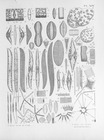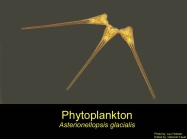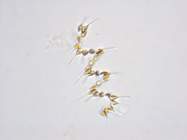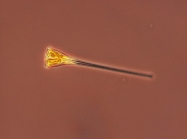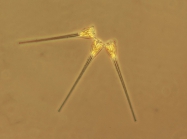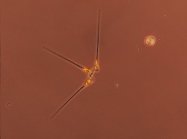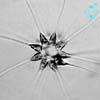
| Intro | | Search taxa | | Browse taxa | | Distributions | | Terminology | | References | | Statistics | | Online sources | | Tutorial | | Log in |
MSBIAS name detailsAsterionellopsis glacialis (Castracane) Round, 1990
149139 (urn:lsid:marinespecies.org:taxname:149139)
uncertain > unassessed
Species
marine
(of Asterionella glacialis Castracane, 1886) Castracane, F. (1886). Report on the diatomaceae collected by H.M.S. Challenger during the years 1873-1876. <em>Report on the Scientific Results of the Voyage of H.M.S. Challenger during the years 1873–76. Botany.</em> 2 (part 4): 1-178, pl. 1-30., available online at http://www.19thcenturyscience.org/HMSC/HMSC-Reports/Bot-04/README.htm
page(s): p. 50; pl. 14, fig. 1 [details]
Kociolek, J.P.; Blanco, S.; Coste, M.; Ector, L.; Liu, Y.; Karthick, B.; Kulikovskiy, M.; Lundholm, N.; Ludwig, T.; Potapova, M.; Rimet, F.; Sabbe, K.; Sala, S.; Sar, E.; Taylor, J.; Van de Vijver, B.; Wetzel, C.E.; Williams, D.M.; Witkowski, A.; Witkowski, J. (2024). DiatomBase. Asterionellopsis glacialis (Castracane) Round, 1990. Accessed through: The UK Marine Environmental Data and Information Network (2024) Marine Species of the British Isles and Adjacent Seas (MSBIAS): a checklist of species derived from the UNICORN and Marine Recorder applications at: https://www.marinespecies.org/msbias/aphia.php?p=taxdetails&id=149139 on 2024-07-06
The UK Marine Environmental Data and Information Network (2024). Marine Species of the British Isles and Adjacent Seas (MSBIAS): a checklist of species derived from the UNICORN and Marine Recorder applications. Asterionellopsis glacialis (Castracane) Round, 1990. Accessed at: https://www.marinespecies.org/msbias/aphia.php?p=taxdetails&id=149139 on 2024-07-06
Date action by 2005-03-30 08:52:46Z created db_admin 2018-01-31 09:33:29Z changed db_admin 2018-02-01 09:09:54Z changed db_admin
original description
(of Asterionella glacialis Castracane, 1886) Castracane, F. (1886). Report on the diatomaceae collected by H.M.S. Challenger during the years 1873-1876. <em>Report on the Scientific Results of the Voyage of H.M.S. Challenger during the years 1873–76. Botany.</em> 2 (part 4): 1-178, pl. 1-30., available online at http://www.19thcenturyscience.org/HMSC/HMSC-Reports/Bot-04/README.htm
page(s): p. 50; pl. 14, fig. 1 [details] context source (Introduced species) Katsanevakis, S.; Bogucarskis, K.; Gatto, F.; Vandekerkhove, J.; Deriu, I.; Cardoso A.S. (2012). Building the European Alien Species Information Network (EASIN): a novel approach for the exploration of distributed alien species data. <em>BioInvasions Records.</em> 1: 235-245., available online at http://easin.jrc.ec.europa.eu [details] Available for editors context source (HKRMS) Lam CWY. & Ho KC. (1988). Phytoplankton characteristics of Tolo Harbour. In: Morton B, editor. Asian Marine Biology 6. pp 5-18. Hong Kong University Press, Hong Kong. [details] context source (Schelde) Maris, T.; Beauchard, O.; Van Damme, S.; Van den Bergh, E.; Wijnhoven, S.; Meire, P. (2013). Referentiematrices en Ecotoopoppervlaktes Annex bij de Evaluatiemethodiek Schelde-estuarium Studie naar “Ecotoopoppervlaktes en intactness index”. <em>Monitor Taskforce Publication Series, 2013-01. NIOZ: Yerseke.</em> 35 pp. (look up in IMIS) [details] basis of record M'harzi, A. (1999). Phytoplankton community structuring in some areas of the North Sea. PhD Thesis. Vrije Universiteit Brussel: Brussel, Belgium. 221 pp. (look up in IMIS) [details] additional source Tomas, C.R. (Ed.). (1997). Identifying marine phytoplankton. Academic Press: San Diego, CA [etc.] (USA). ISBN 0-12-693018-X. XV, 858 pp., available online at http://www.sciencedirect.com/science/book/9780126930184 [details] additional source Horner, R. A. (2002). A taxonomic guide to some common marine phytoplankton. <em>Biopress Ltd. Bristol.</em> 1-195. [details] additional source Martin, J. L.; LeGresley, M. M. ; Strain, P. M. (2001). Phytoplankton monitoring in the Western Isles region of the Bay of Fundy during 1997-98. <em>Canadian Technical Report of Fisheries and Aquatic Sciences 2349.</em> 4: 1-85. [details] additional source Hällfors, G. (2004). Checklist of Baltic Sea Phytoplankton Species (including some heterotrophic protistan groups). <em>Baltic Sea Environment Proceedings.</em> No. 95: 210 pp., available online at http://helcom.fi/Lists/Publications/BSEP95.pdf [details] Available for editors additional source Fourtanier, E. & Kociolek, J. P. (compilers). (2011). Catalogue of Diatom Names. California Academy of Sciences, On-line Version. Updated 2011-09-19., available online at http://researcharchive.calacademy.org/research/diatoms/names/index.asp [details] additional source Krayesky, D. M.; Meave, D. C.; Zamudio, E.; Norris, E.; Fredericq, S.; Tunnell, J. (2009). Diatoms (Bacillariophyta) of the Gulf of Mexico. <em>Gulf of Mexico origin, waters, and biota.</em> 1: 155-186. [details] Available for editors additional source Harper, M.A.; Cassie Cooper, V.; Chang, F.H.; Nelson, W.A.; Broady, P.A. (2012). Phylum Ochrophyta: brown and golden-brown algae, diatoms, silicoflagellates, and kin, in: Gordon, D.P. (Ed.) (2012). New Zealand inventory of biodiversity: 3. Kingdoms Bacteria, Protozoa, Chromista, Plantae, Fungi. pp. 114-163. [details] new combination reference Round, F.E. ; Crawford, R.M. ; Mann, D.G. (1990). The Diatoms. Biology & Morphology of the genera. <em>Cambridge University Press, Cambridge.</em> 747 pp. page(s): p. 664 [details] Available for editors  Present Present  Inaccurate Inaccurate  Introduced: alien Introduced: alien  Containing type locality Containing type locality
|

